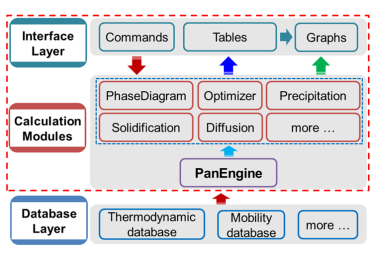Pandat Basics
Pandat™ software is an integrated computational tool developed on the basis of the CALPHAD (CALculation of PHAse Diagram) approach for multi-component phase diagram calculation and materials property simulation. It has a robust thermodynamic calculation engine, a friendly graphical user interface, and a flexible post-calculation table editing function which allows user to plot variety types of diagrams. The software is designed to create a working environment that allows variety of calculation modules be integrated in the same workspace. It currently includes five modules: PanPhaseDiagram (phase diagram and thermodynamic property calculation), PanEvolution/PanPrecipitation (microstructure and precipitation simulation), PanOptimizer (property optimization), PanDiffusion (diffusion simulation), PanSolidification (solidification simulation) and PanPhaseField (phase field simulation). Other modules can be easily integrated into the workspace for extended applications. The architecture of Pandat™ software is schematically shown in the Figure 1.
In addition to the functionalities provided by Pandat™ as a stand-alone program being demonstrated in this manual, its calculation/optimization engine (PanPhaseDiagram, PanOptimizer, PanEvolution/PanPrecipitation, PanDiffusion, and PanSolidification) are built as shared libraries and enable their integration with broader applications in the field of Materials Science and Engineering. More detailed information about Pandat™ software can be found in the published papers [2002Che, 2003Che, 2009Cao].
[2002Chen] L. Q. Chen, “PHASE-FIELD MODELS FOR MICROSTRUCTURE EVOLUTION”, Annu. Rev. Mater. Res. 2002. 32:113–40.
[2003Che] S.-L.Chen et al., “Calculating phase diagrams using PANDAT and PanEngine”, JOM, 55 (2003): 48-51.
[2009Cao] W.S. Cao et al., “PANDAT software with PanEngine, PanOptimizer and PanPrecipitation for multi-component phase diagram calculation and materials property simulation”, Calphad, 33 (2009): 328-342.
